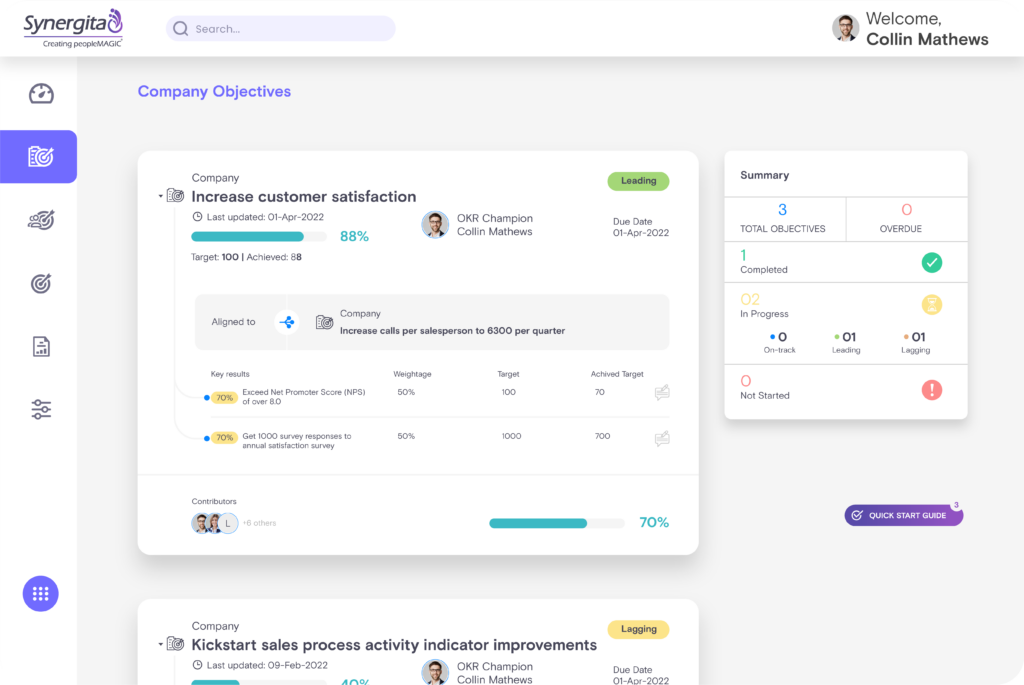Leveraging OKRs for Complete Organizational Efficiency Through Process Automation
Research has shown that team members who are aware of their team’s goals and the importance of the tasks at hand are more productive and committed to their work. So, the key here is to keep your employees in the loop and keep them aware of the company’s goals and objectives.
Once you have ticked that off your list, how do you assess how well your employees meet their objectives and key results (OKRs)? How do you know if they are as productive and committed as you expect them to be?
This is where OKR monitoring steps in. One of the most critical components of an efficient OKR system is tracking. OKR tracking enables you to evaluate your employees’ progress. It also helps you determine whether or not you are on schedule to meet your objectives, such as generating 2X revenue by the end of the next quarter. If your progress shows that it is unlikely that you will accomplish your goal, you know it is time to go back to the drawing board.
OKRs serve as a valuable and relevant tool for creating more cohesive teams and help to motivate and inspire team members. Since the 1970s, OKRs have been mapped out in spreadsheets and paper. And while spreadsheets help organise goals and initiate the process of developing OKRs, as teams and organisations evolve, collaborations increase, and plans become more intertwined, spreadsheets become redundant.
In such cases, automation becomes necessary to enhance the ability to apply OKR tools to such complex networks.

Automating OKRs- A pressing need
Monitoring and assessment of OKRs have moved away from antiquated spreadsheets and toward modern, agile OKR software. These OKR automation software can easily be adapted by businesses and integrated with all the leading technologies used in the industry, enabling teams to deliver quicker and more precise results.
Key Factors in Automating Objectives and Key Results (OKR)
1. Easily assigns goals
You can easily assign goals and tasks to the right team members with the help of suitable OKR software. This makes everyone’s responsibilities and contribution to the organisation’s success systematic and public. This has been proven to boost commitment, focus, and involvement.
2. Seamlessly aligns OKR and company values
Through the use of AI-powered OKR tools, you can ensure that your goals are in line with your company’s values. It is easy to analyse and ensure that the new plans and outcomes are consistent with the core values and principles of the company.
3. Enhances collaboration
OKR software encourages collaboration by facilitating an understanding of each employee’s crucial roles in accomplishing the overall strategic OKRs. Since everyone is working towards the same goal, it becomes evident that a team, not an individual, is essential to accomplish goals.
4. Facilitates goal visualisation
The OKR tool not only enables you to create goals but also enables you to track each OKR’s progress. This way, you can stop anticipating possible problems and focus on achieving your goals.
5. Presents all metrics in one place
With the use of OKR software, businesses can quantify their progress. You can monitor all the critical performance metrics in one place. The OKR software’s dashboard makes it simple to identify the company’s top priorities and the metrics you must monitor to ensure success. And the best is that through cloud bases solutions, managers and team members can quickly access all the data.
Best OKR examples for organisational success
Because aligning and cascading OKRs can be challenging, you should consider OKRs as corporate-wide initiatives where several functional teams promote the goals and take ownership of the primary outcomes.
As a result, OKRs should be regarded as team OKRs rather than individual OKRs. To get you started, use these examples. Instead of replicating them exactly, try using them as inspiration and develop specific OKRs for your team and company.
Increase our brand’s visibility and reach outside of the present geographic area.
Key Result 1:Each week, produce one new piece on thought leadership.
Key Result 2: Boost weekly newsletter signups by 100.
Key Result 3: Boost Website traffic from new target by 10%.
Bring in as many qualifying leads as possible to assist the sales team.
Key Result 1: Create three new case studies focusing on new customer segments
Key Result 2:Updated product and offering information should be reflected in the standard sales deck and talk track.
Key Result 3: Increase leads from web forms by 2X.
Boost the delivery quality of the engineering team.
Key Result 1:Reduce the number of bugs and problems discovered during development by 50%.
Key Result 2: Lower the number of bugs customers report following significant releases.
Key Result 3: 100% of releases should have a retro.
Increase the hiring of new employees to strengthen and expand the team’s capabilities.
Key Result 1: Start recruitment drives on three employment sites.
Key Result 2: Establish a program for employee referrals.
Key Result 3: Reduce the hiring time from 35 to 25 days.
OKRs can be robust and scalable tools for managing and tracking the accomplishment of ambitious goals. You can boost the agility of enterprise execution by using Synergita’s OKR tool to create a real-time dynamic process. Synergita also allows for automatic tracking of OKRs so that your business can benefit from horizontal knowledge sharing and transparency.
So, are you interested to know how OKRs can help you organise your organisational strategy and promote alignment? Sign Up and see how you can transform and automate your OKR strategy.
Related Topics:

